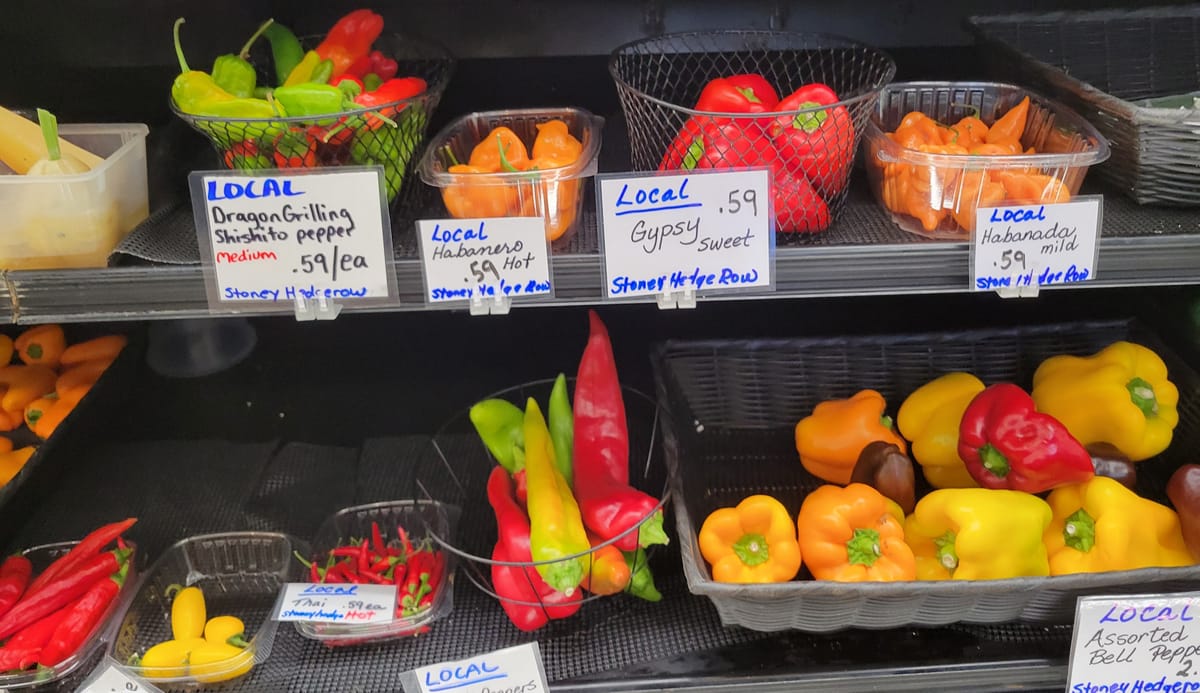On My Plate: Peppers
I recently found five colors of sweet or bell peppers in the Farmers Market: red, yellow, purple, orange and green.

Several dozen varieties of locally grown hot and sweet (or bell) peppers are currently available at Oxford’s Farmers Market and MOON Co-op Grocery. Although they seem quite different, sweet and hot peppers are part of the same Capsicum genus. The difference: Hot peppers contain the chemical capsaicin, whereas sweet peppers do not.
The bell pepper, which is a type of sweet pepper, most likely originated in Mexico, according to Oxford resident and long-time eminent Miami Botany professor Hardy Eshbaugh, an international authority on its origin. Most other members of the Capsicum genus originated in Bolivia. Bell peppers have thicker skins and are more suitable for stuffing, whereas elongated or Italian-style sweet peppers can be more flavorful.
Christopher Columbus bears responsibility for mistakenly applying the word “pepper” to both peppercorns and sweet and hot peppers. Columbus sailed from Europe in part to find peppercorns, highly prized in Europe at the time and known to grow in India. Thinking he had reached India, Columbus brought back to Europe what he thought were peppercorns. Though sweet and hot peppers were soon recognized as something different than peppercorns, Europeans termed “pepper” as anything hot and spicy.
I recently found five colors of sweet or bell peppers in the Farmers Market: red, yellow, purple, orange and green. All sweet peppers start green, but the brightly colored ones – especially the red ones – have ripened longer, ergo are sweeter. Most frequently, I simply chop them and add them to either a lettuce-based salad or whatever I’m cooking.
My Romanian heritage in-laws prized stuffed peppers, and the Romanian cookbook I inherited – Poftă Bună – has two recipes for ardei umpluţi (stuffed peppers), one of which has an asterisk indicating the family’s preference. Green bell peppers (not brightly colored ones) are stuffed with a mix of ground meat and rice, covered with a multi-ingredient tomato-based sauce and cooked in the oven or on the stovetop for a long time. With respect to my in-laws, the recipe is time-consuming and the result too heavy for a summer meal.
One of my Italian cookbooks has a recipe for stuffing a pepper suitable for using local produce in abundance this time of year. Halve a bell pepper, remove the stems and seeds, place the two halves face up in a baking dish, stuff them with a mixture of mashed leftover eggplant and chopped tomatoes, top with cheese and bake at 350 for 1/2 hour.
I rarely use hot peppers, but their history is interesting. The heat level of a hot pepper is measured according to the Scoville Heat Unit (SHU). The measuring system was invented in 1912 by pharmacist Wilbur Scoville. He prepared and repeatedly diluted a sample of chili with sugar-water until five test subjects no longer felt any heat. Not a job I would want.
The score on the scale represents the level of dilution required for the sensation of heat to disappear completely. Since the 1980s, high-tech machines have largely replaced human tasters, but the result is still converted to SHU.
Scoville may have had an Oxford connection. He married Cora Upham, and Miami’s President between 1928 and 1945 was Alfred Upham. Cora and Alfred were born within a decade of each other, so perhaps they were distant cousins.
If you want help in selecting a hot pepper, ask Craig Harkrider at the Farmers Market. I’m happy limiting my selection to his wide variety of sweet and bell peppers.
James Rubenstein is president of the Board of Directors for the Oxford Free Press and professor emeritus of geography at Miami University.




